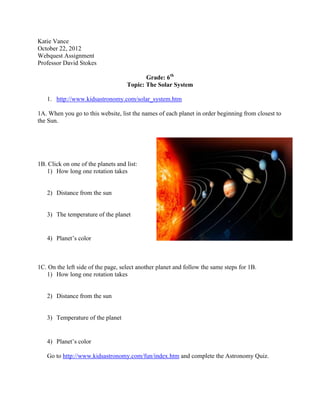
Webquestfinal
- 1. Katie Vance October 22, 2012 Webquest Assignment Professor David Stokes Grade: 6th Topic: The Solar System 1. http://www.kidsastronomy.com/solar_system.htm 1A. When you go to this website, list the names of each planet in order beginning from closest to the Sun. 1B. Click on one of the planets and list: 1) How long one rotation takes 2) Distance from the sun 3) The temperature of the planet 4) Planet‟s color 1C. On the left side of the page, select another planet and follow the same steps for 1B. 1) How long one rotation takes 2) Distance from the sun 3) Temperature of the planet 4) Planet‟s color Go to http://www.kidsastronomy.com/fun/index.htm and complete the Astronomy Quiz.
- 2. Have you noticed a difference in each of the Planets? Why are they all different colors and different temperatures? Go through the website to answer the following questions. 2. http://www.universetoday.com/35664/temperature-of-the-planets/ 2A. T or F Mercury is the closest planet to the Sun, therefore it has a burning surface. T or F There are currently 8 planets in our Solar System T or F Venus has the highest average temperatures of any planet because of its proximity to the Sun and its thick atmosphere 2B. (Fill in the blanks) Uranus is the planet with a recorded temperature of . Although Uranus is far from the Sun, that is not the only reason why it is so cold. All of the other gas giants in our Solar System give off heat from their cores than they receive from the Sun. 3. Go to http://www.youtube.com/watch?v=97Ob0xR0Ut8 to learn about the sizes of the planets. The Solar System is a lot bigger than you think! 3A. Write to interesting facts that you learned from the video: 1. 2.
- 3. 4. http://kids.nineplanets.org/ 4A. though this website is called “nine planets”, what change has been made at the top of the page and why? Be sure to scroll down to answer the question correctly. 4B. Click on „click on the portal to explore the planets!‟ link and list the planets of the inner and outer solar system. Inner: Outer: 4C. the Asteroid belt is what separates the inner and outer planets. Click on „Asteroid Belt‟ to learn more. What are asteroids? Now we are going to look further into other parts of Space: asteroids, comets, and meteors. 5. http://science.discovery.com/video-topics/space-videos/asteroids.htm Click on the link to watch a video about asteroids! 5A. Write three characteristics of an asteroid 1. 2. 3.
- 4. Click on the next link to learn about comets 6. http://scienceforkids.kidipede.com/physics/space/comet.htm 6A. (Fill in the blanks) Comets are balls of leftover and that were originally part of a formed when a exploded into a . 6B. T or F These balls formed into planets when most of the material in our nebula merged together, about 4.5 billion years ago. If false, explain what happens instead. 7. Go to http://solarsystem.nasa.gov/kids/meteors_kids.cfm to learn more about asteroids and meteors and to answer 7A. 7A. Match the words on the right with the correct fact on the left Impact craters -The biggest space rocks. Asteroids Meteoroids -Smaller pieces of rock and iron that orbit our Sun. Meteor meteorite -A space rock that enters into Earth‟s atmosphere. -A meteor that makes it all the way to the ground without burning up. - Earth's Moon, Mercury and even Mars are covered withthese from collisions of meteors and asteroids. Impact CraterMeteor Satellites in our Solar System
- 5. The last part of the Solar System that we will explore is about satellites that orbit our planet. 8. Go to http://www.factmonster.com/dk/science/encyclopedia/satellites.html 8A.What is a satellite? A. An object that circles another in space B. The moon C. An object that can relay phone calls, TV broadcasts, and can monitor weather D. All of the above 8B.What is the name of the first artificial satellite? A. USSR B. Sputnik 1 C. ORBIT D. October E. 1957 8C. Satellites are built of the lightest materials possible to make them easier to launch. What types of instruments can satellites carry? 1. 3. 2. 4. Just for fun! A manmade satellite that is currently orbiting Earth is the Hubble Space telescope which was launched into orbit in 1990. The 43.5 foot long telescope takes beautiful color pictures of objects like dying stars and other galaxies. Orbiting the Earth for over two decades, Hubble has helped to answer some of the most compelling astronomical questions of our time- and uncovered mysteries we never knew existed. http://www.youtube.com/watch? v=fgg2tpUVbXQ ANSWER KEY
- 6. 1A. Mercury, Venus, Earth, Mars, Jupiter, Saturn, Uranus, Neptune 1B. answer varies 1C. answer varies 2A. False, True, True 2B. coldest, lowest, -224 C, more 3A. answer varies 4A. Astronomers have demoted Pluto to a “dwarf planet”. There are only eight planets. 4B. Inner: Mercury, Venus, Earth, Mars Outer: Jupiter, Saturn, Uranus, Neptune 4C. Asteroids are chunks of rock and metal that orbit around the Sun. Scientists think that they are loose material that never formed into planets. 5A. answer varies 6A. rock, ice, nebula, star, supernova 6B. False 7A. Asteroids, meteoroids, meteor, meteorite, impact craters 8A. D 8B. B 8C. cameras, telescopes, radiation sensors, radio equipment